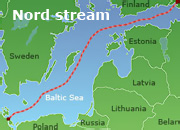The vessel is planned to stay there for approximately two years, laying the majority of the Nord Stream natural gas pipeline.
Denmark’s Great Belt Bridge, the gateway to the Baltic Sea, is almost seven kilometres long. With a vertical clearance of 65 metres, even the world’s largest cruise ship could pass under it. No special precautions need to be taken to allow the Castoro 6 to pass.
The Nord Stream Pipeline is scheduled to transport natural gas to Europe from 2011. Pipe-laying activities will commence in the Swedish Exclusive Economic Zone, about 30 kilometres off the coast of the Swedish island of Gotland. From there, the Castoro 6 will slowly move north toward the Gulf of Finland, laying the pipeline at the rate of up to 2.5 kilometres per day.
Before pipe laying could start, Nord Stream spent several years carefully planning the pipeline route, taking account of environmental factors from fish spawning and bird migration to sediment and bedrock geology, as well as social and economic aspects such as ship traffic and fishing activities.
A sophisticated HSE (health, safety and environment) plan and an environmental monitoring system have been developed. All equipment and procedures have been developed and tested to meet internationally-recognised standards.
Offshore production requires thorough planning: each of the parallel 1,224 kilometre long Nord Stream pipelines will consist of about 100,000 concrete weight coated steel pipes weighing about 25 tons each. To ensure uninterrupted pipe-laying, pipe-carrier vessels will continuously deliver pipes to the pipelay vessel. On board, the 12 metre long pipes will be prepared for welding. Then, each pipe will first be welded to another one to form a 24 metre long double pipe, and then these double pipes will be welded onto the pipeline in the vessel’s central production line. Every millimetre of each weld will undergo thorough testing and the vessel will move ahead, slowly lowering the pipeline on to the seabed.
17 Декабря 2025 | среда | 14:56


